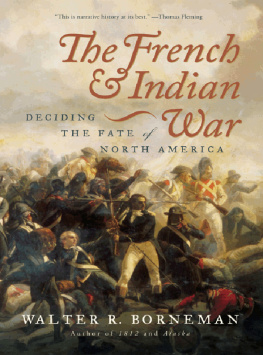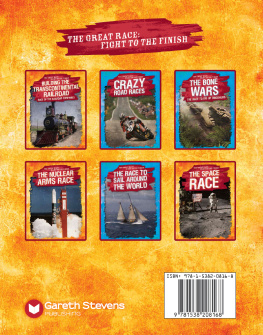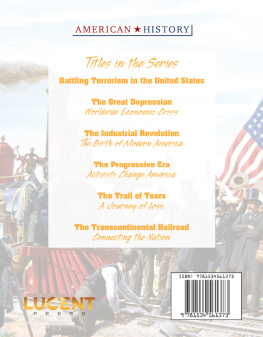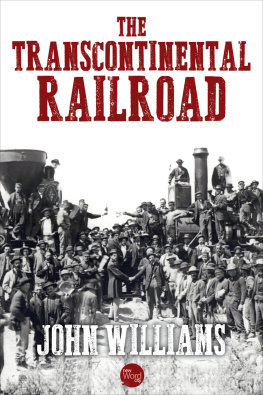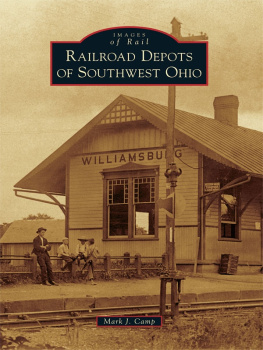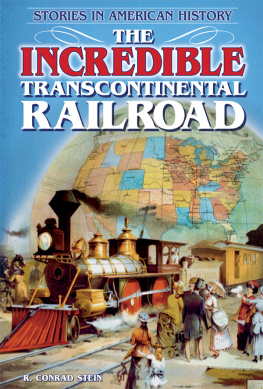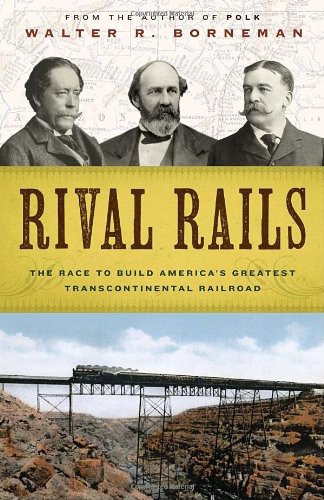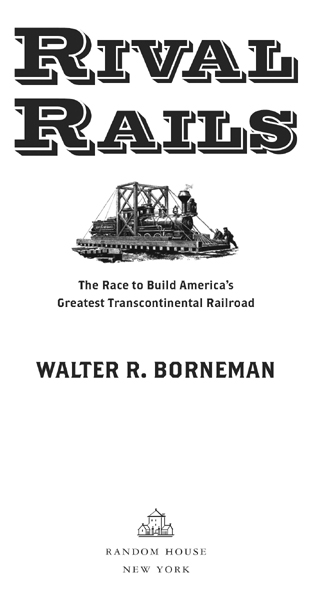ALSO BY WALTER R. BORNEMAN
Polk: The Man Who Transformed the Presidency and America
The French and Indian War: Deciding the Fate of North America
1812: The War That Forged a Nation
Alaska: Saga of a Bold Land
A Climbing Guide to Colorados Fourteeners
(WITH LYNDON J. LAMPERT)
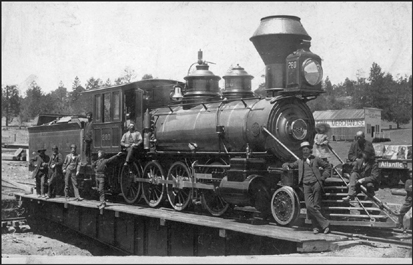
Atchison, Topeka and Santa Fe locomotive no. 280, a 2-8-0 consolidation with balloon stack, attracted a crowd on the turntable atop Glorieta Pass; this section between Lamy and Las Vegas, New Mexico, was tough mountain railroading, and helper engines were routine. (Denver Public Library, Western History Collection, A. Frank Randall, Z-5460)
Copyright 2010 by Walter R. Borneman
All rights reserved.
Published in the United States by Random House, an imprint of The Random House Publishing Group, a division of Random House, Inc., New York.
R ANDOM H OUSE and colophon are registered trademarks of Random House, Inc.
Library of Congress Cataloging-in-Publication Data
Borneman, Walter R.
Rival rails : the race to build Americas greatest transcontinental railroad / Walter R. Borneman.
p. cm.
eISBN: 978-0-679-60392-4
1. RailroadsUnited StatesHistory19th century. 2. RailroadsUnited StatesHistory20th century. I. Title. HE2751.B67 2010
385.097309034dc 2009047297
Maps by David Lambert
Locomotive drawings by Henry Comstock
www.atrandom.com
v3.1
For
Alexander C. Hoyt,
with cause
Contents
Part I:
Opening Gambits (1853-1874)
Part II:
Contested Empire (1874-1889)
Part III:
Santa Fe All the Way (1889-1909)
List of Maps
Introduction

Railroad Battleground
A mong my earliest memories are those of being down at the railroad depot with my grandfather, watching the trains come in. It was the 1950s, and I wish I had realized then what an era was passing before my eyes. I grew up dreaming of airplanes and space travel, but my fascination with railroads never left me. Ironically, fifty years later, there has been a great resurgence in Americas dependence on rails. It will never be the same as the Santa Fe Super Chief, of course, or the California Zephyr that I rode west from Chicago with Grandpa and Grandma, but Americas commerce still rides the railsno more so than on the direct Los Angeles-to-Chicago super route across the American Southwest.
Much has been written about Americas first transcontinental railroad, but driving the golden spike at Promontory Summit in 1869 signaled merely the beginning of the transcontinental railroad saga. The preCivil War notion that only one rail line would cross the continent vanished on the prairie winds. The rest of the country was suddenly up for grabs. Dozens of railroads, all with aggressive empire builders at their helms, raced one another for the ultimate prize of a southern transcontinental route that was generally free of snow, shorter in distance, and gentler in gradients.
The Denver and Rio Grande Railways gentleman general, William Jackson Palmer, put his railroads three-foot narrow gauge rails up against the big boys. The Atchison, Topeka and Santa Fes William Barstow Strong and Edward Payson Ripley made sure that the routes were staked and won, and then created a textbook example of efficiency upon them. Collis P. Huntington, having already won half the West for the Central Pacific, determined to control the other half for the Southern Pacific. Above them all floated the shadowy hand of Jay Gould, a man who bought and sold railroads as readily as some men traded horses.
Meanwhile, tens of thousands of ordinary men waged a different type of war: the herculean task of constructing the bridges, tunnels, cuts, and fills of these empires and hurriedly flinging track across wild and wide-open country. Among their challenges were vast distances, high elevations, tortuous canyons, unruly rivers, and two towering walls of mountains. The better routes were often not to be sharedadmitting no passage wider than the ruts of a wagon or the steel rails of a single track of railroad.
From wagon ruts to a railroad empire, this is the story of the battles to control the heavily contested transportation corridors of the American Southwest and to build Americas greatest transcontinental route through them. When the dust finally settled, the southern route linking Los Angeles and Chicago had become the most significant of the nations transcontinental railroads.
Railroads and Railroaders

A Cast of Characters
RAILROADS
There are hundreds, perhaps thousands, of railroad names scattered about the American West. The vast majority were paper railroads, incorporated legally to hold a route, bluff an opponent, or appease local economic interestsall without laying a single railroad tie. Many of the companies that incorporated and actually laid track went through a succession of names because of mergers, acquisitions, and reorganizations after bankruptcy. Sometimes the change was no more than for Railroad to become Railway or vice versa. Many of these, too, drifted into oblivion or became part of larger enterprises. Finally, the principal contenders were frequently forced by state or territorial laws to incorporate separate corporations within certain boundaries.
References herein are usually to the major railroads without distinction to their numerous controlled affiliates, subsidiaries, or joint ventures. This list is by no means definitivenor even comprehensive of the railroads in this bookbut it is an effort to identify the key roads.
A note about ampersands: The ampersand (&) is a staple of railroading, but its usage was varied and highly inconsistent. Consequently, and is used herein in railroad names to avoid confusion.
ATCHISON, TOPEKA AND SANTA FE Organized in 1860, the railroad finally started construction in 1868 and eventually became the dominant transcontinental system in the southwestern United States.
ATLANTIC AND PACIFIC Forced into early receivership, the Atlantic and Pacific Railroad emerged as a joint venture of the Santa Fe and Frisco railroads and eventually became the key link in the Santa Fes main line across Arizona.
CALIFORNIA SOUTHERN With capital from Santa Fe investors, the California Southern built north from San Diego to San Bernardino and eventually over Cajon Pass.
CENTRAL PACIFIC The western end of the first transcontinental, the Central Pacific was the foundation of the Big Four s (Crocker, Hopkins, Huntington, and Stanford) empire and became an important part of the Southern Pacific system.
CHICAGO, BURLINGTON AND QUINCY Known most readily as the Burlington, the railroad had preCivil War origins but became a transcontinental contender when it built west to Colorado and later pioneered the Zephyr streamliners.


